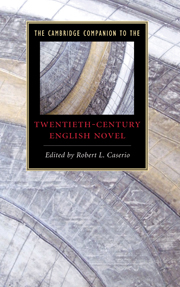Book contents
- Frontmatter
- Introduction
- 1 The art of English fiction in the twentieth century
- 2 The British Empire and the English modernist novel
- 3 Realism and rebellion in Edwardian and Georgian fiction
- 4 The Great War in English fiction
- 5 Postwar modernism in the 1920s and 1930s: The mammoth in the basement
- 6 Regionalism in English fiction between the wars
- 7 Ireland and English fiction
- 8 Feminist fiction
- 9 Working-class fiction across the century
- 10 World War II, the welfare state, and postwar “humanism”
- 11 The Windrush generation
- 12 History in fiction
- 13 Postmodernisms of English fiction
- 14 Detectives and spies
- 15 The post-consensus novel: Minority culture, multiculturalism, and transnational comparison
- 16 An absurd century: Varieties of satire
- 17 The other side of history: Fantasy, romance, horror, and science fiction
- Further reading
- Index
1 - The art of English fiction in the twentieth century
Published online by Cambridge University Press: 28 July 2009
- Frontmatter
- Introduction
- 1 The art of English fiction in the twentieth century
- 2 The British Empire and the English modernist novel
- 3 Realism and rebellion in Edwardian and Georgian fiction
- 4 The Great War in English fiction
- 5 Postwar modernism in the 1920s and 1930s: The mammoth in the basement
- 6 Regionalism in English fiction between the wars
- 7 Ireland and English fiction
- 8 Feminist fiction
- 9 Working-class fiction across the century
- 10 World War II, the welfare state, and postwar “humanism”
- 11 The Windrush generation
- 12 History in fiction
- 13 Postmodernisms of English fiction
- 14 Detectives and spies
- 15 The post-consensus novel: Minority culture, multiculturalism, and transnational comparison
- 16 An absurd century: Varieties of satire
- 17 The other side of history: Fantasy, romance, horror, and science fiction
- Further reading
- Index
Summary
“Fascinating and strangely unfamiliar,” Virginia Woolf declared Percy Lubbock's new book to be in a 1922 TLS review essay. Woolf was referring neither to the literary biographies for which Lubbock was known nor to the novel that he had yet to write but to The Craft of Fiction, his recently published study of the novel as a literary art. “To say that it is the best book on the subject is probably true,” Woolf judges, “but it is more to the point to say that it is the only one. He has attempted a task which has never been properly attempted, and has tentatively explored a field of inquiry which it is astonishing to find almost untilled” (p. 338). Modernism famously invents itself by imagining the new century as a rupture with the past, and in the first three decades of the twentieth century part of what it meant to fulfill the Poundian imperative to “make it new” was to keep track of the cultural “firsts” as they abounded. The compliment of origination and exceptionalism that Woolf pays Lubbock is one that in The Craft of Fiction and elsewhere Lubbock himself pays to Henry James, the “novelist who carried his research into the theory of the art further than any other - the only real scholar in the art.” Lubbock has in mind the analysis conducted in eighteen prefaces that James wrote for the New York Edition of his best work, selected by (as Lubbock, with an even more extravagant display of indebtedness, proclaimed him) “the master” himself. The prefaces are presented by James as a loving retrospective, an intimate reencounter, with his favorite literary creations. But because for James the creative enterprise was inseparable from his strong sense of the novel as an aesthetic form, Lubbock found in the prefaces a powerful articulation not of one man's “original quiddity” but of the literary properties common to all novels (p. 187).
- Type
- Chapter
- Information
- Publisher: Cambridge University PressPrint publication year: 2009
- 2
- Cited by



